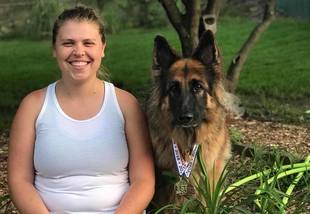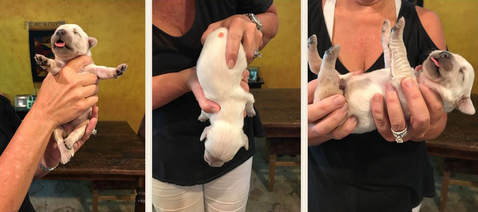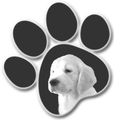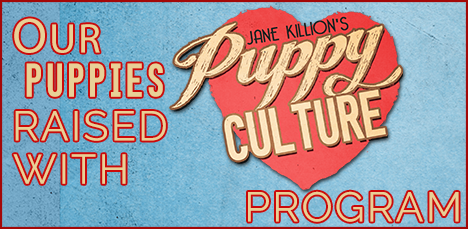Alycia Noble
Puppy Culture (PC) Trainer / Puppy Party Coordinator
Bio
 Alycia and her dog Hannah
Alycia and her dog Hannah
Alycia Noble is a local dog enthusiast and Kashmir Goldens’ Puppy Culture trainer. She believes that many of the issues facing dogs and their families today can be prevented by carefully breeding, raising and placing puppies in appropriate homes. Alycia has teamed up with Kashmir Goldens to implement the Puppy Culture protocols that will give the puppies the best possible start in life.
Alycia is a hobby dog trainer who has spent 6 years learning dog behavior, how to train in the most effective and humane way and the best way to raise puppies. She follows the Puppy Culture rearing program and has helped implement the protocols on all of Kashmir Goldens recent litters (which include many puppies that have gone on to do service and therapy work).
Alycia has made local presentations on Puppy Culture and is a valued contributor and sought out advisor to the Puppy Culture community on social media who is constantly looking to learn more about how to improve rearing protocols. She is happy and honored to be a part of the Kashmir Goldens Kennel team.
Alycia is a hobby dog trainer who has spent 6 years learning dog behavior, how to train in the most effective and humane way and the best way to raise puppies. She follows the Puppy Culture rearing program and has helped implement the protocols on all of Kashmir Goldens recent litters (which include many puppies that have gone on to do service and therapy work).
Alycia has made local presentations on Puppy Culture and is a valued contributor and sought out advisor to the Puppy Culture community on social media who is constantly looking to learn more about how to improve rearing protocols. She is happy and honored to be a part of the Kashmir Goldens Kennel team.
|
If you are a breeder/owner interested in Alycia's services, please contact her personally for prices and availability. Email: [email protected] Facebook: https://www.facebook.com/pucknoble |
Puppy Culture Protocols

Early Neurological Stimulation (ENS) – ENS is a protocol created by a military dog breeding program that has been proven to increase tolerance to stress, provide greater resistance to disease and produce stronger heat beats. These lifelong benefits are gained by purposely stressing the puppies mildly when they are small, before they ears or eyes open. This protocol takes very little time, but provides significant benefits to the puppies.
More information on ENS
More information on ENS
|
|
Barrier Challenge - The goal of the Barrier Challenge is to improve the puppy’s problem solving skills and to increase their tolerance for frustration. To do that we put food on one side of an exercise pen and the puppy on the other side. The puppy can see and smell the food, but they must go around the exercise pen to get to it. This is a challenge that most puppies can figure out on their own after a short amount of time being frustrated. They are rewarded for their hard work of finding their way to the food with a little snack :)
We will increase the difficulty of these challenges as the puppies ability to problem solve develops. |
Charging the Clicker - The "clicker" is a common training tool that is used to communicate with a dog during training that they have done something correctly and that a reward is coming. For the "click" to have meaning, the dog/puppy must have an understanding that a treat follows the "click".
Here, we are conditioning the puppies to the "click" and teaching them that yummy food comes after the "click". Once they understand that a click communicates "good job, here comes a treat", we can then use the clicker to aid in training other behaviors.
Here, we are conditioning the puppies to the "click" and teaching them that yummy food comes after the "click". Once they understand that a click communicates "good job, here comes a treat", we can then use the clicker to aid in training other behaviors.
The Box Game - The main goal of the box game is to teach the puppies that their behavior can cause the human to “click” and give them a reward. We use a box because it is a cheap and simple object that puppies can interact with. During this exercise we will click and treat for any offered interaction between the puppy and the box. The puppies soon learn to try lots of different behaviors, hoping that they will be rewarded.
A puppy that understands that they have some control over the training session, helps keep them more engaged and usually makes training more fun for everyone :)
A puppy that understands that they have some control over the training session, helps keep them more engaged and usually makes training more fun for everyone :)

Manding – Manding is a term that comes from the Autistic community vocabulary that means a form of communication used to ask for something. The Puppy Culture community adopted the term and uses it to mean – a default behavior that a puppy can use to ask for something. Most people use “sit” as the default behavior. Once the puppy understands that it can be rewarded for sitting, you see puppies start to ask for things by sitting. You will see a puppy sit at your feet for attention instead of jumping. You will see puppies sitting at the door to ask to be let out instead of barking or just not knowing how to ask and having an accident.
To teach manding we reinforce puppies offering to sit. We do not teach the puppies to sit on command because we want the sit to be their idea. That does not mean that you cannot teach your puppy to sit when you ask “sit”, but they won’t come to you home knowing what “sit” means. They should come to your home offering sits for things that they want and you can reinforce them by rewarding them with petting, play and treats when you see them offer sits.
To teach manding we reinforce puppies offering to sit. We do not teach the puppies to sit on command because we want the sit to be their idea. That does not mean that you cannot teach your puppy to sit when you ask “sit”, but they won’t come to you home knowing what “sit” means. They should come to your home offering sits for things that they want and you can reinforce them by rewarding them with petting, play and treats when you see them offer sits.
|
Crate Conditioning – We start crate conditioning at 4 weeks of age and work on it until puppies go to their new homes. Our only goal with crate conditioning is to teach puppies that crates are safe places to be and that awesome things happen inside of crates (meals, chews, nap time).
At 4 weeks old, we put crates (doors removed) into the weaning box and move the puppy’s beds into the crates. The puppies are able to choose to enter/stay in or exit the crates all they want that week. They often choose to sleep in the crates because that is where the soft beds are. At 5 weeks, we start feeding puppies their meals in the crates. This adds an extra layer of excitement for being in the crates and by the end of the week we start closing the crate door while they are eating. We allow the puppies out of the crate at any time if they ask. At 6 weeks, we start feeding them chews and frozen yummies in the crates and close the doors. |
We start with about 5 minutes of chew time and continue working on this until they go home, at which time they can choose to stay in their crates up to 30 minutes at a time.
Our puppies will not go home crate trained, but they will have had many, many positive experiences in their crates and should feel comfortable in crates at their new homes. It will be their new owner’s responsibility to continue that positive association as they grow. |


